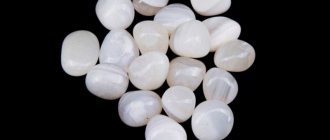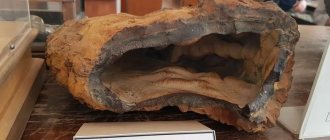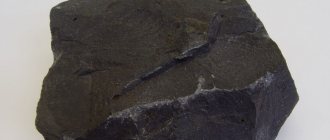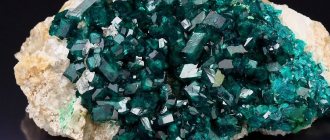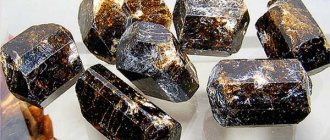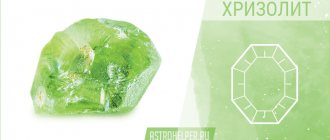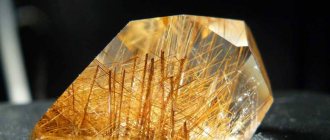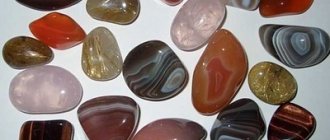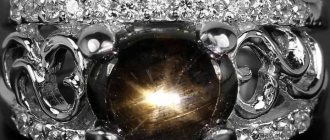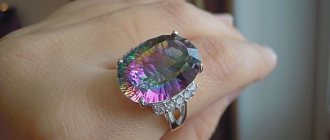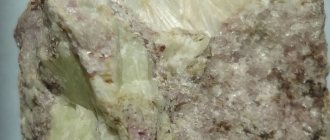Albite is a natural stone belonging to the plagioclase group and is the main type of feldspar. It is a mineral that most often occurs as twin intergrowths in igneous, infusional and intrusive rocks of igneous origin. Its crystals have a transparent, translucent and opaque structure with a glassy luster.
The main color range is white and gray tones; crystals of blue, brown, green, yellow and orange are less common, the saturation of which is influenced by the amount of chemical impurities.
The basic formula of the mineral is Na[AlSi3O8], but quite often its composition contains impurities of potassium, magnesium, calcium, chromium and lead. Dense albite crystals are resistant to heat, melting and acidic compounds. Only hydrofluoric acid can dissolve them.
Varieties of albite
Based on its structure and physical properties, albite is classified into the following varieties:
- A high mineral with a disordered structure and resistance to temperatures above 800°C;
- Low mineral with an ordered structure and resistance to temperature barriers of 700°C;
- Peristerist is a translucent stone with adularization and iridescence present;
- Clevelandite is a type of lamellar albite;
- Pericline - elongated crystals of pure white shades.
- Belomorite is similar in structure to peristerist, but the color palette includes violet, gray and blue-blue shades.
The appearance of albite became the basis for its name, which is from the Latin “albus” meaning “white”. However, along with white shades, the mineral contains gray colors, which become most noticeable after polishing due to the optical effect.
History and origin of the stone
Albit is a “young” stone. It received its name in 1815, when it was first discovered by Swedish geologists. They included it in the register of minerals, but did not attach much importance to it.
Later in the 20th century, Russian scientist Alexander Fersman discovered interesting examples of white with blue and purple hues on the White Sea coast. And he gave it the name - belomorite. But some experts separate belomorite and albite, considering the first mineral a variety of the second.
There is evidence that the stone was used in Ancient countries (Greece, India) for ritual ceremonies. It was believed that it helps to establish contact with the dead.
According to legend, with the help of albite it was possible to influence the celestial bodies.
Mineral deposits
Despite the fact that albite deposits are located throughout the planet, finding mineral deposits in their pure form is not so easy. Basically, it is mined together with other rocks and minerals, and deposits are classified depending on the purpose of its further use.
Transparent crystals, from which beautiful jewelry is made, are mined on the African continent - in Kenya, Zimbabwe and Madagascar. Large mines of albite, which is used industrially, are located in the United States (Pennsylvania, Georgia and Virginia) and in the vicinity of Ottawa.
Many mineral deposits are located in Russia. Transparent stones are mined in the Irkutsk region, the Middle Urals and the Kola Peninsula. The surroundings of the Malkhansky ridge of Southern Transbaikalia are famous for the mining of collection samples of clevelandite - lamellar albite, which is also found in California, USA.
Large crystals are mined in Binntal in Switzerland and Minas Geras in Brazil. Stones mined in the Eastern Pamirs of Tajikistan and the northern part of Norway have an iridescent effect. Back to contents
Chemical composition
Chemical theoretical composition of pure albite (NaAlSi3O8): Na2O - 11.82; Al2O3 - 19.44; SiO2 - 68.74. Molecular weight 262.24. Variations in the theoretical composition of plagioclases of the albite series (Ano-5): Na2O - 11.82-11.19; CaO - 0.00-1.07; Al2O3 - 19.44-20.35; SiO2 - 67.39-68.74. Variations in the theoretical composition of albite in the series of K,Na-feldspars (Ab100-Ab95Or5): Na2O - 11.82-11.19; K2O- 0.00-0.89; Al2O3 - 19.44-19.38; SiO2 - 68.74-68.53.
Varieties
Clevelandite - cleavelandite. A lamellar, flattened (010) variety of albite, widespread in zones of hydrothermal alteration in granitic pegmatites. Named after the American mineralogist Parker Cleveland (1780-1858) of Bowdoin College, Brunswick, NY. Maine because it was thought to be a new mineral species. Identified with Dehn's albite (1844). Sometimes any lamellar albite is incorrectly called clevelandite. It is formed in the form of curved or curved plates, flattened along (010), forming wedge-shaped subparallel masses. In Chesterfield, such plates reach 5-6 cm in length, 2 cm in width and a thickness of 1-2 mm. No edges other than (010) are usually observed. Sometimes in the form of spherical or cylindrical masses (“tubes”) intergrown with quartz and muscovite, reaching 2.5 m in diameter (for example, in the Old Mike pegmatite in the Black Hills, USA). Spherical masses with radially oriented clevelandite leaves along the periphery, up to 90 cm in diameter, are described in Branchville, PC. Connecticut, USA. Similar formations up to 2.5 m in diameter are described from the Globa pegmatite, Rio Ariba County, pc. New Mexico, USA. Twins according to the albite law are described. The cleavage is perfect. Very fragile. The color is white, light gray, often blue, rarely red. Pearlescent luster on the plane. (010). At Chesterfield, clevelandite is found in granitic pegmatite in association with green and pink tourmaline, quartz and muscovite. Blue clevelandite is common in rare-metal pegmatites in association with spodumene, polychrome tourmaline (often with rubellite), beryl, montebrasite, etc.
Pericline - pericline (Breithaupt, 1830) with elongation of crystals along the b axis [010] and pericline type of twinning, described from St. Gotthard, Switzerland (contained an admixture of potassium - 2.5 wt.% K2O). Varieties not currently distinguished; zygadite, described from Andreasberg in the Harz; hyposclerite (Breithaupt, 1930) from Arendal in Aust-Agder, Norway; olafite - olafite from Snarum in Buskerud; tetartine (Rose, 1883).
Albit crystal on serpentine
Crystallographic characteristics
Syngony. Triclinic.
Class. Pinacoidal.
Crystal structure
Framed lattice with a continuous three-dimensional frame.
In the structure of low albite, “drive shafts” of TO4 tetrahedra, forming chains elongated along the a axis, are connected in the form of a garland of quadruple rings with a strictly ordered distribution of Si and Al. A specific feature of the albite structure is the high anisotropy of the electron density of the Na atom with a higher isotropic thermal factor than Si, Al and oxygen, which corresponds to the “smearing” of the Na position with an amplitude of 0.13 A in the ± plane of the b axis and 0.18 A along the b axis b.
The reasons for this anisotropy were discussed in (Smith, 1954). According to it, it is caused either by the anisotropy of thermal vibrations of Na inside the cavity of the alkali atom in the Si,Al frame, caused by the asymmetric arrangement of the surrounding [(Si,Al)O4] tetrahedra in triclinic feldspar, or by the splitting of the Na position into two (or more) “ subsites" Na(1) and Na(2) with a resolution along the Y axis of 0.1 A. Refinement of the structure at a low temperature of 93 K (-180°) showed that the resolution of the subsites should be even greater (0.27 A) and they are inclined to the Y axis at an angle of 19°, however, the effect of changing the thermal factor from room temperature to -180° was more significant than the experimentally found bifurcation, and it is impossible to decide whether the anisotropy of the Na atom is caused by the splitting of its position into Na(1) and Na (2) or anisotropy of thermal vibrations. Studies by Winter et al. at high temperatures showed that the Na atom in low albite (but not in high albite) vibrates anisotropically around one center.
Magical properties of albite
A pyramid made of the mineral albite
Practicing magicians and esotericists call albite a conductor of two energies: the Moon and the Sun. The lunar mineral symbolizes Yin energy, the solar one – Yang. For harmony in a person, the balance of these two energies must be constantly maintained. That is why experts recommend wearing albite in pairs, charging each of the stones with its own energy. To do this, one crystal is laid out in the light of the full moon and hidden in a dark place during the day. The second stone, on the contrary, should be placed in the sun during the day and carefully hidden from moonlight at night.
The mineral has a beneficial effect on the human psyche, relieving stress, excitability and nervousness. It is simply necessary for emotional and impressionable individuals who react painfully to external stimuli. The stone will give them patience, calmness and poise.
The magical properties of a talisman with two stones will help normalize your emotional state and gain confidence in your own abilities. Albit will also act as a powerful talisman for the home. If you hang it above the front door, then negativity and dark forces will bypass the home.
The energy of albite can be increased by placing it together with a ruby, agate or emerald in a pyramid for 15 minutes.
Albit is an effective talisman for travelers. The gem will help them overcome difficulties on the road, as well as resolve issues with overnight stays and crossing borders. The mineral of the water element will also become a strong amulet for people whose life and activities are connected with the sea.
History (mythology)
Even in ancient times, there was a belief that the aura of the stone had magical properties. According to legend, the mineral serves as a conductor of the energies of the Sun and Moon. In China, even today, there is a ritual of using albite to achieve harmony with the Universe. The mystery of the stone is that it is used only in even numbers for wearing. One part should include lunar rock, and the other – solar rock.
People say that the stone will gain lunar power if it is placed on a window for charging on a new moon. During the day you need to place the mineral in a secluded place. Another stone is usually placed on the window during the daytime.
Paired natural stones are perfect for wearing as talismans. Their owner can manage his life wisely and protect himself from mistakes. The person will also cleanse himself of negativity from the outside.
It should be remembered that one stone will not bring the desired success; you need to use only a paired mineral.
In order for its properties to become stronger, you need to temporarily build a pyramid with agate, emerald or ruby. Then the gem will become even stronger and protect against negativity.
The mineral has magical properties, helps the owner gain clarity of mind and the worldview of a philosopher, remain calm and not nervous even in the most difficult situations. If you use it as a talisman for your home, then hang the gem above the front door. The stone will not allow evil forces and ill-wishers into the room.
Medicinal properties
In folk medicine, albite is used to prevent and alleviate chronic diseases of the abdominal organs: kidneys, liver, stomach, spleen and pancreas. The stone is considered an effective autoimmune remedy, suppresses depression and stress, promotes clarity of thought, reducing mental stress.
To experience the healing properties of a mineral, you do not have to carry it with you all the time. Albit treats with tactile contact, for which you need to take a horizontal position, apply it to the problem area and relax. The crystal will absorb discomfort and pain and significantly alleviate the patient’s condition.
After each procedure, the stone must be “freed” from the negative, for which it is held for 5 minutes under running water.
Back to contents
Zodiac sign
This is a universal mineral that is favorable for all zodiac signs. This stone emits only positive energy and cannot be dangerous. It is believed that albite bestows peace and tranquility. It has a special influence on water signs, Pisces, Scorpio, Cancer. An amulet with this mineral can be worn by Leos. Astrologers believe that you need to have two amulets made of this stone with you. A person must maintain a balance of lunar and solar flows, Yin energy and Yang energy. Each of the amulets should be charged, one with the energy of the moon, the second with the energy of the sun.
Medicinal properties
In medicine, this feldspar is used to eliminate problems in the gastrointestinal tract (liver, kidneys, spleen, pancreas, stomach). The stone is applied to the affected areas and left for a short time. Such manipulations should be carried out in a quiet, comfortable place; the patient must be in a horizontal position and relaxed. Only in this case will the healing properties of the stone appear. After use, the mineral should be placed in cool spring water for 20 minutes. This must be done so that the stone can get rid of the negative currents that it absorbed upon contact with the patient.
Areas of application of albite
The mineral is of genuine interest to scientists due to its twinning properties and crystalline form. It is actively used in gemological studies of the process of metamorphism, as it is directly involved in the formation of rocks.
In its pure form, albite, due to its hardness, as well as resistance to abrasion and heat, has found wide use in the abrasive, glass, ceramic and refractory industries. Ceramic dishes containing albite are widely popular due to their durability.
In construction, it is used as a finishing material and crushed stone, which is added to concrete solutions for their reliable setting.
In jewelry, albite is classified as “moon stones” and is not used very often. Beautiful jewelry is made from pure cut stones - beads, bracelets, earrings and pendants. Transparent cabochon-cut crystals, as well as naturally shaped specimens combining a mixture of several minerals, attract the attention of collectors.
Albit prices
Products made from this mineral are affordable. At stone fairs and in specialized stores, their cost varies within the following range:
- Ring in a silver frame – $25-30.
- Cabochon pendant – $7-10.
- Necklace – $25-40.
- Earrings in a cupronickel frame – $10-12.
- Souvenir ball – $70-80.
- Polished egg up to 6 cm high – $60-65.
- Albite crystal intergrown with tourmaline – $45-155 depending on the size of the sample.
Physico-chemical characteristics of albite
Albite consists of aluminum, silicon, sodium and oxygen.
It also contains inclusions, such as chromium, lead, potassium, calcium and magnesium, which determine the color of the mineral. Albite crystals with a triclinic system, colorless, white-bluish or gray-bluish. They have a glassy luster, translucent or transparent. Hardness on the Mohs scale from 6 to 6.5. The density is 2.65 g/cm3. At the fracture, the crystals are uneven and conchoidal. Their shape is tabular or lamellar; twin and fan-like specimens are much less common. Frame crystal lattice. Cleavage is medium to perfect.
Albite is slightly soluble in acids; it is only affected by hydrofluoric acid, which decomposes it. It doesn't melt well.
Associated minerals for albite are wodginites, struverites, muscovites, and orthoclases.
Difference from fake
Albit
Albit is often counterfeited, offering glass, plastic or the most common feldspar instead of the natural mineral. You can distinguish a fake stone from a real one by several signs:
- Heat resistance and refractoriness - natural albite does not melt under the influence of the fire of a candle or match, which cannot be said about a fake stone.
- Acid resistance – albite does not react to hydrochloric or sulfuric acid. The exception is hydrofluoric acid.
- Low thermal conductivity - real albite conducts heat poorly; it will heat up in the palm for a long time, unlike synthetic analogues.
It is rare to find counterfeits of regular albite on the stone market. Basically, ungodly craftsmen are interested in unique transparent, colored and plate crystals, which they try to cleverly copy and sell at the price of a real gem.
Links[edit]
- https://rruff.geo.arizona.edu/doclib/hom/albite.pdf Handbook of Mineralogy
- ^ a b https://www.mindat.org/min-96.html Mindat.org
- https://www.webmineral.com/data/Albite.shtml Webmineral data
- One or more of the preceding sentences incorporates text from a publication now in the public domain: Chisholm, Hugh, ed. (1911). "Albit". Encyclopedia Britannica
(11th ed.). Cambridge University Press. - OF Tuttle, N. L. Bowen (1950): High-temperature albite and adjacent feldspars. J. Geol. 58(5), 572–583, https://www.jstor.org/stable/30068571
- "High Albite". www.mindat.org
. - Monalbite on Mindat
- JP Greenwood, PC Hess (1998): Congruent melting of albite: theory and experiment. J. Geophysical Research. 103 (B12), 29815-29828
- "Anorthoclase". www.minerals.net
. - "Clevelandite". www.mindat.org
. - "Associated minerals". www.mindat.org
. - Bulk Gemstone Guide – Gem Secrets Revealed
By Pao Nipperkin - "Uses of Albite". britannica.com
. Retrieved April 4, 2022.
Stone care
Albit is easy to care for and therefore does not require any special recommendations. It is enough to store the mineral in a soft case or box and protect it from falls and shocks due to its high fragility. If the stone does break or split, it is not recommended to wear it. The fragments should be collected very carefully, as they are very sharp due to their needle-like shape.
In case of contamination, albite is washed in cool water with the addition of baby soap, then rinsed and wiped with a soft piece of cloth. When actively using a stone for healing or magical purposes, it is temporarily placed in a saline solution. This will neutralize the negative energy that albite has absorbed.
Horoscope
Albit can be used as an astrological talisman by absolutely all representatives of the zodiac system, except for signs of the element of Fire. Leos, Aries and Sagittarius are categorically not recommended to use the energy of the stone, as it has a destructive effect on the character and fate of its owner. Otherwise, this is a “positive” stone that will not harm anyone, but will only bestow peace and harmony.
He especially favors the signs of the Water element (Pisces, Scorpios and Cancers). The mineral will help them establish connections with other representatives of the Zodiac, balance the manifestation of negative and positive character traits, and bring good luck. Other signs can wear albite and use its properties, but their manifestation will not be as pronounced. Back to contents
